(十七)ATP应用测试平台——Redis实现API接口访问限流(固定窗口限流算法)
Posted 北溟溟
tags:
篇首语:本文由小常识网(cha138.com)小编为大家整理,主要介绍了(十七)ATP应用测试平台——Redis实现API接口访问限流(固定窗口限流算法)相关的知识,希望对你有一定的参考价值。
前言
开始正文之前,大多数情况下应该有这样一段场景。面试官:说说平常在项目中,你是如何使用redis的?我:我们就很简单啦,比如前后端分离token的存储、短信验证码的存储,权限列表的存储,一些热点数据的存储。再高大上一点,分布式锁。面试官:还有呢?心中顿时一万只草泥马奔过,这还不够吗?还能干什么?不好意思,实在是想不出了。面试官,好了,回去等通知吧。
其实对于redis的使用万变不离其踪,归根结底是对redis的某些特性的利用,例如其所有操作都是的原子性、数据可以设置过期时间、低延迟高吞吐量。redis分布式锁正是基于redis的这些基本特性实现的。本节内容我们使用redis实现接口API的访问限流,这里提供spring的interceptor拦截器和aop切面俩种方式实现接口api的细粒度限流,根据实际情况,选择一种方式即可。说到限流我们前面已经介绍过在微服务中使用阿里巴巴的产品sentinel实现限流,sentinel是功能更加强大限流产品。本节内容我们是基于redis自身的一些特性实现限流,相对来说还是一种比较通俗易懂的实现限流方式,包括在springcloud-gateway网关服务中也可以使用redis限流,其已内置到网关中,具体的实现步骤我们后面有时间在叙。
正文
- 引入redis的pom依赖
<!--redis启动器-->
<dependency>
<groupId>org.springframework.boot</groupId>
<artifactId>spring-boot-starter-data-redis</artifactId>
</dependency>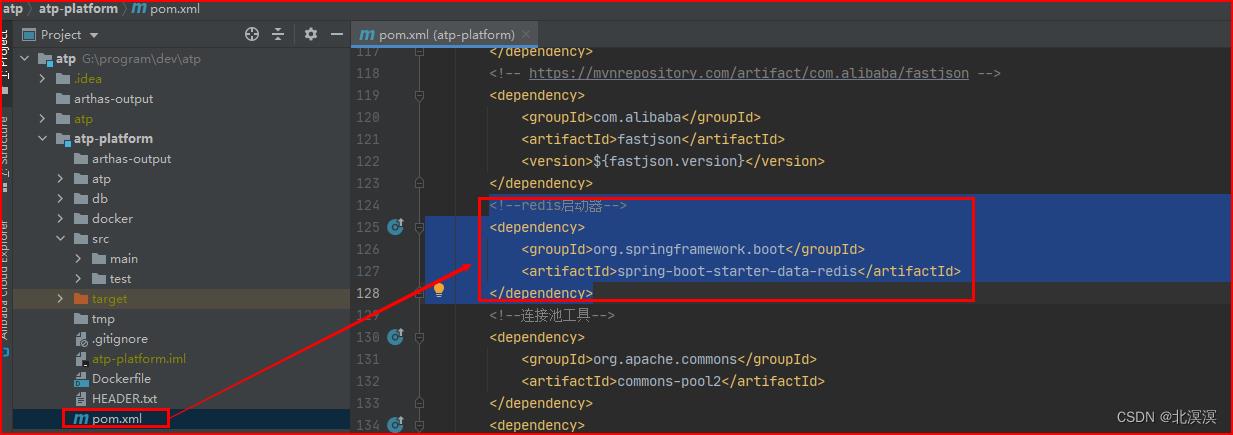
- application.yml中配置redis服务
spring:
redis:
#默认数据分区
database: 0
#redis集群节点配置
cluster:
nodes:
- 192.168.56.10:6379
- 192.168.56.10:6380
- 192.168.56.10.6381
max-redirects: 3
#超时时间
timeout: 10000
#哨兵节点配置
sentinel:
master: mymaster
nodes:
- "192.168.56.10:26379"
- "192.168.56.10:26380"
- "192.168.56.10:26381"
#redis密码
password: root
#redis 客户端工具
lettuce:
pool:
# 连接池最大连接数(使用负值表示没有限制) 默认为8
max-active: 8
# 连接池中的最小空闲连接 默认为 0
min-idle: 1
# 连接池最大阻塞等待时间(使用负值表示没有限制) 默认为-1
max-wait: 1000
# 连接池中的最大空闲连接 默认为8
max-idle: 8
- 在类路径下创建限流的lua脚本
local flow_key = KEYS[1]
local flow_count = tonumber(ARGV[1])
local flow_time = tonumber(ARGV[2])
local current = redis.call('get', flow_key)
if current and tonumber(current) > flow_count then
return tonumber(current)
end
current = redis.call('incr', flow_key)
if tonumber(current) == 1 then
redis.call('expire', flow_key, flow_time)
end
return tonumber(current)
- lua脚本说明
#限流传入的key
local flow_key = KEYS[1]
#限流传入的达到访问请求的上限限流次数
local flow_count = tonumber(ARGV[1])
#限流传入的达到访问请求的限流时间范围,默认是秒
local flow_time = tonumber(ARGV[2])
#判断当前限流的key是否存在
local current = redis.call('get', flow_key)
#如果存在,并且达到了上限限流次数,返回当前的访问次数,tonumber将value值转换为int值
if current and tonumber(current) > flow_count then
return tonumber(current)
end
#将限流的key值加1操作
current = redis.call('incr', flow_key)
if tonumber(current) == 1 then
#如果是第一次访问,设置其过期时间,即限流时间范围
redis.call('expire', flow_key, flow_time)
end
#返回当前的限流次数
return tonumber(current)- redis缓存工具类创建与lua脚本组件注入
@Configuration
public class RedisConfig
/**
* redis缓存工具类创建
* @param redissonConnectionFactory
* @return
*/
@Bean
public RedisTemplate<String, Object> redisTemplate()
// 缓存序列化配置,避免存储乱码
RedisTemplate<String, Object> template = new RedisTemplate<>();
Jackson2JsonRedisSerializer jackson2JsonRedisSerializer = new Jackson2JsonRedisSerializer(Object.class);
ObjectMapper objectMapper = new ObjectMapper();
objectMapper.setVisibility(PropertyAccessor.ALL, JsonAutoDetect.Visibility.ANY);
objectMapper.activateDefaultTyping(LaissezFaireSubTypeValidator.instance ,
ObjectMapper.DefaultTyping.NON_FINAL, JsonTypeInfo.As.PROPERTY);
jackson2JsonRedisSerializer.setObjectMapper(objectMapper);
StringRedisSerializer stringRedisSerializer = new StringRedisSerializer();
// key采用String的序列化方式
template.setKeySerializer(stringRedisSerializer);
// hash的key也采用String的序列化方式
template.setHashKeySerializer(stringRedisSerializer);
// value序列化方式采用jackson
template.setValueSerializer(jackson2JsonRedisSerializer);
// hash的value序列化方式采用jackson
template.setHashValueSerializer(jackson2JsonRedisSerializer);
template.afterPropertiesSet();
return template;
/***
* lua脚本组件初始化
* @return
*/
@Bean
public DefaultRedisScript<Long> defaultRedisScript()
DefaultRedisScript<Long> redisScript = new DefaultRedisScript<>();
redisScript.setScriptSource(new ResourceScriptSource(new ClassPathResource("lua/flow_limit.lua")));
redisScript.setResultType(Long.class);
return redisScript;
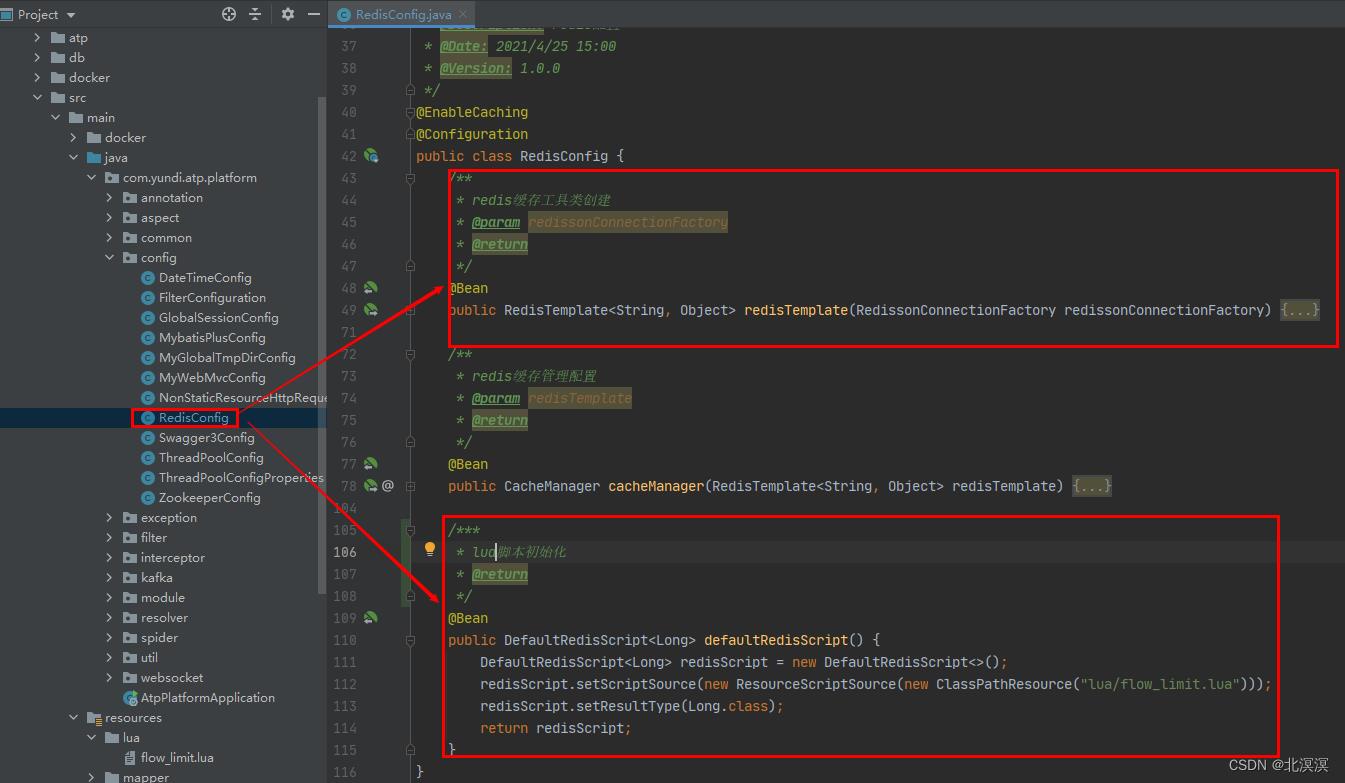
- 创建限流的枚举类FlowLimitType
package com.yundi.atp.platform.common;
public enum FlowLimitType
/**
* 默认限流策略(全局限流)
*/
GLOBAL,
/**
* 根据IP地址限流
*/
IP,
/**
* 根据用户ID限流
*/
USER
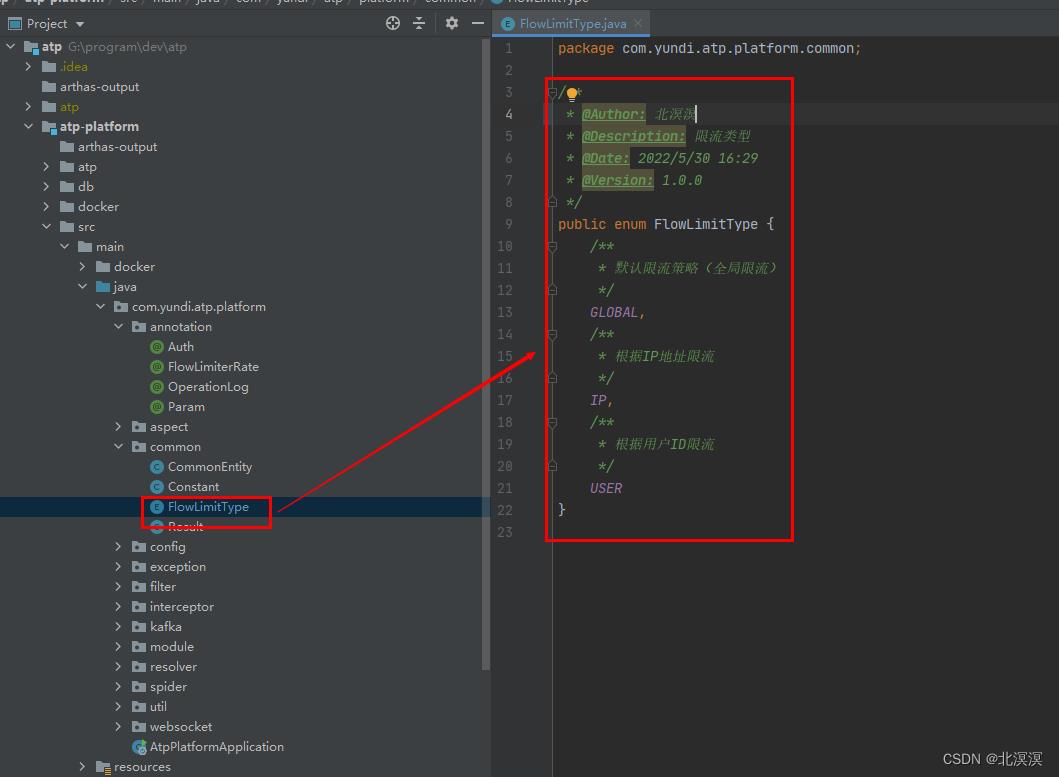
- 创建限流注解,实现基于注解的定制化限流
package com.yundi.atp.platform.annotation;
import com.yundi.atp.platform.common.FlowLimitType;
import java.lang.annotation.*;
@Target(ElementType.METHOD)
@Retention(RetentionPolicy.RUNTIME)
@Documented
public @interface FlowLimiterRate
/**
* 限流策略:默认使用IP
*/
FlowLimitType flowLimitType() default FlowLimitType.IP;
/**
* 限流key前缀:key_flow_limit_rate
*/
String flowLimitKey() default "key_flow_limit_rate:";
/**
* 限流时间段,单位秒
*/
int flowLimitTime() default 5;
/**
* 限流次数
*/
int flowLimitNumber() default 10;
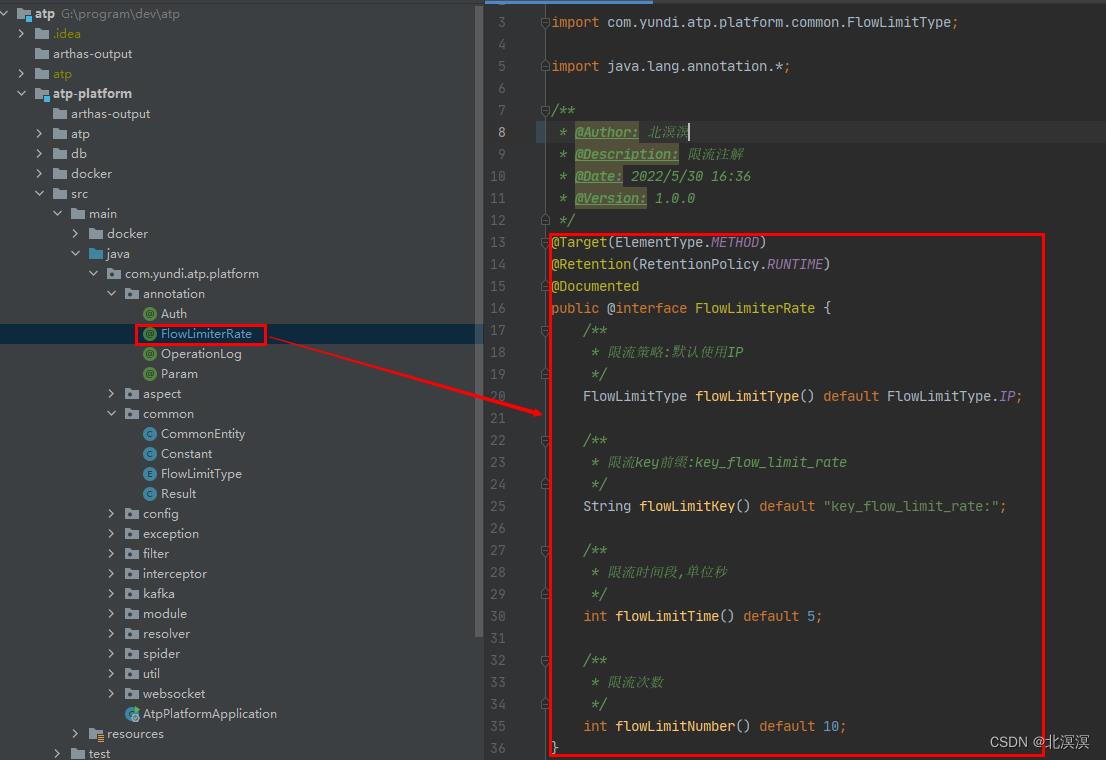
- 创建一个限流拦截器FlowLimiterHandlerInterceptor用于限流处理
package com.yundi.atp.platform.interceptor;
import com.fasterxml.jackson.databind.ObjectMapper;
import com.yundi.atp.platform.annotation.FlowLimiterRate;
import com.yundi.atp.platform.common.FlowLimitType;
import com.yundi.atp.platform.common.Result;
import lombok.extern.slf4j.Slf4j;
import org.springframework.data.redis.core.RedisTemplate;
import org.springframework.data.redis.core.script.DefaultRedisScript;
import org.springframework.stereotype.Component;
import org.springframework.web.context.WebApplicationContext;
import org.springframework.web.context.support.WebApplicationContextUtils;
import org.springframework.web.method.HandlerMethod;
import org.springframework.web.servlet.HandlerInterceptor;
import javax.servlet.http.HttpServletRequest;
import javax.servlet.http.HttpServletResponse;
import java.io.IOException;
import java.util.Arrays;
@Slf4j
@Component
public class FlowLimiterHandlerInterceptor implements HandlerInterceptor
/**
* 执行controller方法前
*
* @param request
* @param response
* @param handler
* @return
* @throws Exception
*/
@Override
public boolean preHandle(HttpServletRequest request, HttpServletResponse response, Object handler) throws Exception
log.info("开始流量监控咯");
if (handler instanceof HandlerMethod)
FlowLimiterRate methodAnnotation = ((HandlerMethod) handler).getMethodAnnotation(FlowLimiterRate.class);
if (methodAnnotation != null)
//限流类型
FlowLimitType flowLimitType = methodAnnotation.flowLimitType();
//限流key
String flowLimitKey = methodAnnotation.flowLimitKey();
//限流时间
Integer flowLimitTime = methodAnnotation.flowLimitTime();
//限流次数
Integer flowLimitNumber = methodAnnotation.flowLimitNumber();
log.info("限流类型:,限流key:,限流时间:,限流次数:", flowLimitType, flowLimitKey, flowLimitTime, flowLimitNumber);
//判断限流规则:IP
if (FlowLimitType.IP.equals(flowLimitType))
//查询url
String requestURI = request.getRequestURI();
//查询ip
String ipAddr = getIpAddr(request);
//拼接key
String key = flowLimitKey + ipAddr + ":" + requestURI;
log.info("key:", key);
//获取RedisTemplate实例
RedisTemplate redisTemplate = (RedisTemplate)this.getBean("redisTemplate", request);
//RedisScript实例
DefaultRedisScript<Long> defaultRedisScript = this.getBean(DefaultRedisScript.class, request);
Long number = (Long) redisTemplate.execute(defaultRedisScript, Arrays.asList(key), flowLimitNumber, flowLimitTime);
if (number == null || number.intValue() > flowLimitNumber)
log.info("访问过于频繁,请稍候再试");
limitResult(response);
return false;
log.info("限制请求'',当前请求'',缓存key''", flowLimitNumber, number.intValue(), key);
//todo 根据访问用户限流
return true;
/**
* 达到限流要求的响应结果
* @param response
* @throws IOException
*/
public void limitResult(HttpServletResponse response) throws IOException
response.setCharacterEncoding("UTF-8");
response.setContentType("application/json; charset=utf-8");
ObjectMapper objectMapper = new ObjectMapper();
response.getWriter().println(objectMapper.writeValueAsString(Result.fail("请求访问频繁,请稍后再试!")));
return;
/**
* 获取ip地址
*
* @param request
* @return
*/
private String getIpAddr(HttpServletRequest request)
String ip = request.getHeader("X-Real-IP");
if (ip != null && !"".equals(ip) && !"unknown".equalsIgnoreCase(ip))
return ip;
ip = request.getHeader("X-Forwarded-For");
if (ip != null && !"".equals(ip) && !"unknown".equalsIgnoreCase(ip))
int index = ip.indexOf(',');
if (index != -1)
return ip.substring(0, index);
else
return ip;
else
return request.getRemoteAddr();
/**
* 根据类型获取容器对象实例
*
* @param clazz
* @param request
* @param <T>
* @return
*/
private <T> T getBean(Class<T> clazz, HttpServletRequest request)
WebApplicationContext applicationContext = WebApplicationContextUtils.getRequiredWebApplicationContext(request.getServletContext());
return applicationContext.getBean(clazz);
/**
* 根据名称获取容器对象实例
*
* @param beanName
* @param request
* @return
*/
private Object getBean(String beanName, HttpServletRequest request)
WebApplicationContext applicationContext = WebApplicationContextUtils.getRequiredWebApplicationContext(request.getServletContext());
return applicationContext.getBean(beanName);
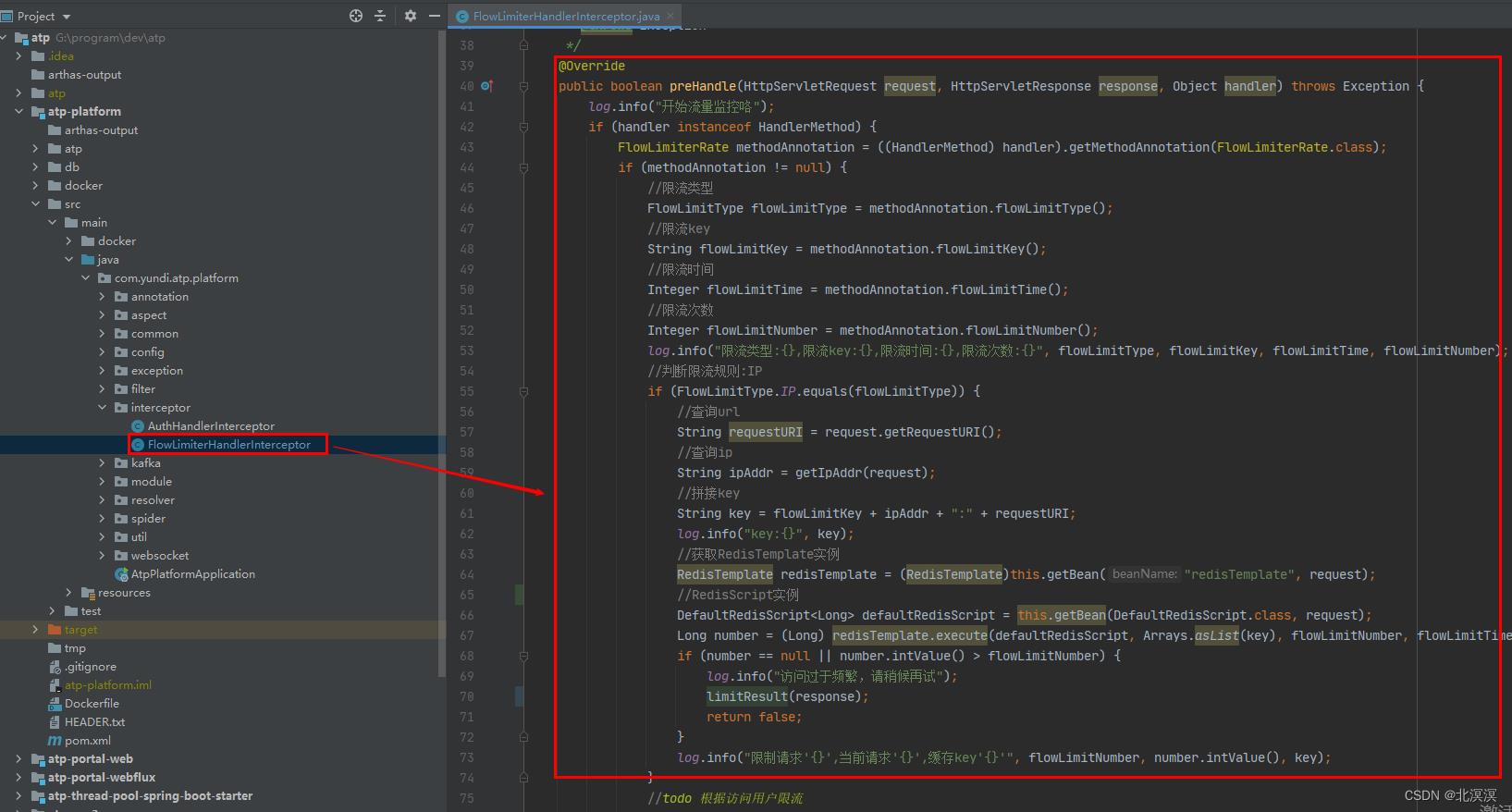
- 注册限流拦截器
package com.yundi.atp.platform.config;
import com.yundi.atp.platform.interceptor.AuthHandlerInterceptor;
import com.yundi.atp.platform.interceptor.FlowLimiterHandlerInterceptor;
import com.yundi.atp.platform.resolver.ParamHandlerMethodArgumentResolver;
import org.springframework.context.annotation.Configuration;
import org.springframework.web.method.support.HandlerMethodArgumentResolver;
import org.springframework.web.servlet.config.annotation.InterceptorRegistry;
import org.springframework.web.servlet.config.annotation.ResourceHandlerRegistry;
import org.springframework.web.servlet.config.annotation.WebMvcConfigurer;
import java.util.List;
/**
* @Author: 北溟溟
* @Description: 添加静态资源文件,外部可以直接访问地址
* @Date: 2021/5/18 10:54
* @Version: 1.0.0
*/
@Configuration
public class MyWebMvcConfig implements WebMvcConfigurer
/**
* 注册拦截器
* @param registry
*/
@Override
public void addInterceptors(InterceptorRegistry registry)
registry.addInterceptor(new AuthHandlerInterceptor()).addPathPatterns("/**").order(1);
//注册限流拦截器
registry.addInterceptor(new FlowLimiterHandlerInterceptor()).addPathPatterns("/**").order(2);
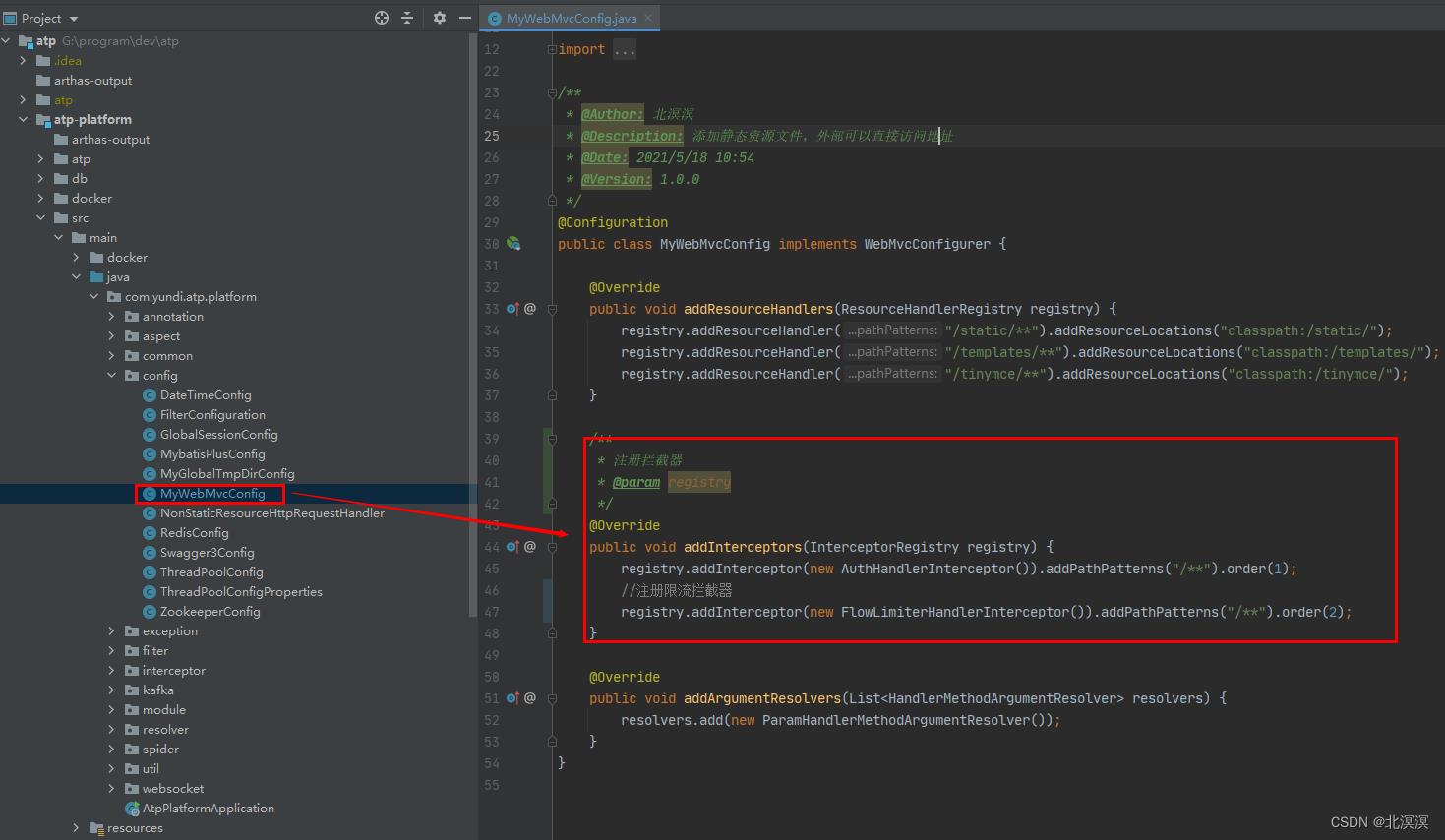
- 测试限流controller
@Slf4j
@Api(tags = "用户管理")
@RestController
@RequestMapping("/sys/user")
public class UserController
@Autowired
private UserService userService;
@FlowLimiterRate(flowLimitType = FlowLimitType.IP,flowLimitKey = "key_flow_limit_rate_user:",flowLimitTime = 5,flowLimitNumber = 3)
@ApiOperation(value = "查询用户详情")
@PostMapping(value = "/info")
public Result info(@RequestParam(value = "id") String id)
User user = userService.findUserInfoById(id);
return Result.success(user);
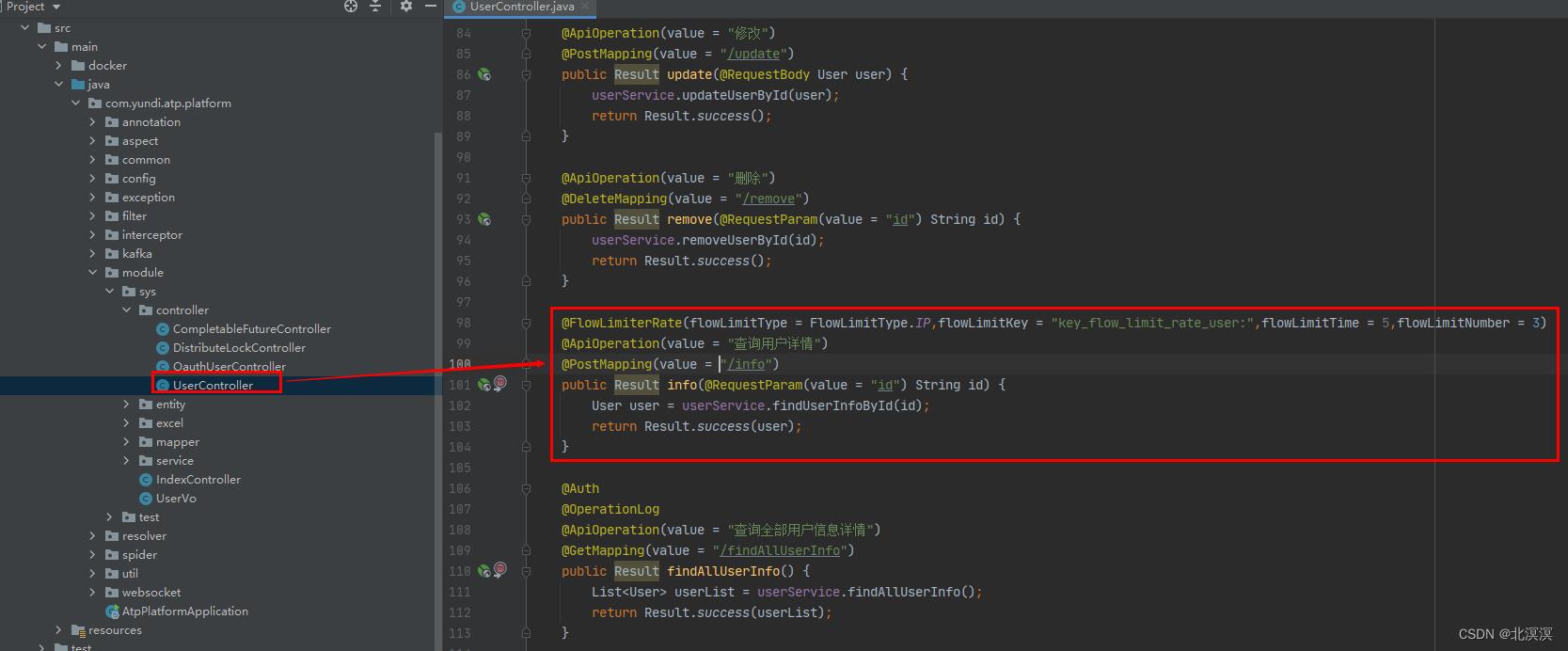
- 测试结果
这里设置的是在5秒内,如果访问次数超过3次,就会发生限流
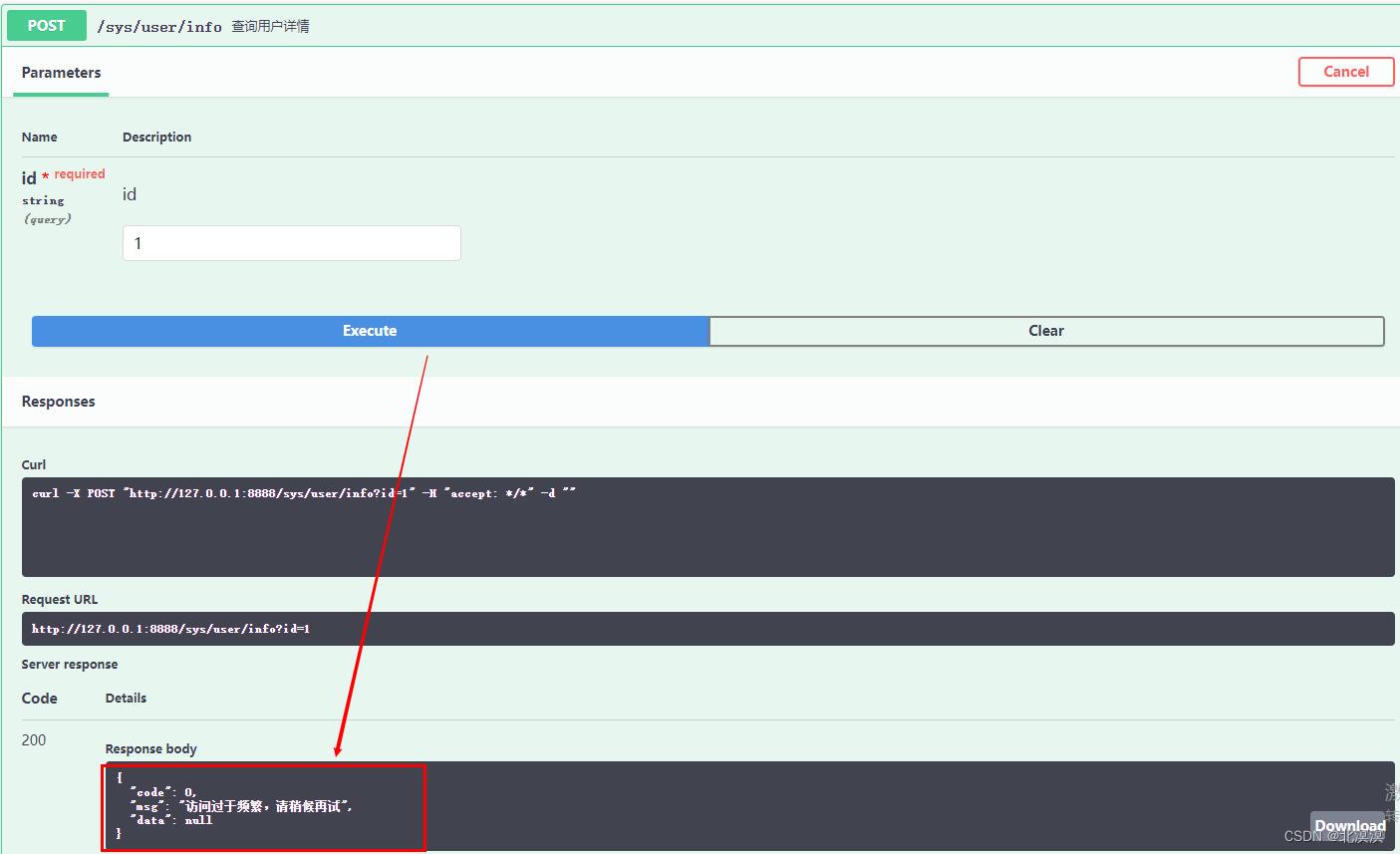
- aop的实现方式与拦截器基本一致,这里只提供aop的实现代码,其它同上,实际在使用过程中任选一种方式即可,aop的方式更加灵活,既可以通过注解的方式也可以指定切面去做限流。
package com.yundi.atp.platform.aspect;
import com.yundi.atp.platform.annotation.FlowLimiterRate;
import com.yundi.atp.platform.common.FlowLimitType;
import com.yundi.atp.platform.exception.BizException;
import lombok.extern.slf4j.Slf4j;
import org.aspectj.lang.JoinPoint;
import org.aspectj.lang.annotation.Around;
import org.aspectj.lang.annotation.Aspect;
import org.aspectj.lang.annotation.Before;
import org.aspectj.lang.annotation.Pointcut;
import org.springframework.beans.factory.annotation.Autowired;
import org.springframework.context.annotation.Configuration;
import org.springframework.data.redis.core.RedisTemplate;
import org.springframework.data.redis.core.script.DefaultRedisScript;
import org.springframework.web.context.request.RequestContextHolder;
import org.springframework.web.context.request.ServletRequestAttributes;
import javax.servlet.http.HttpServletRequest;
import java.util.Arrays;
@Aspect
@Slf4j
@Configuration
public class FlowLimiterAspect
@Autowired
RedisTemplate redisTemplate;
@Autowired
DefaultRedisScript defaultRedisScript;
/**
* 切点:注解方式
*/
@Pointcut("@annotation(com.yundi.atp.platform.annotation.FlowLimiterRate)")
public void flowLimiterPointCut()
/**
* 切点:固定切面方式
*/
@Pointcut(value = "execution(* com.yundi.atp.platform.module.test.controller.*.*(..))")
public void flowLimiterPackagePointCut()
/**
* 注解版:针对特定接口的限流规则
*
* @param joinPoint
* @param flowLimiterRate
*/
@Before(value = "flowLimiterPointCut() && @annotation(flowLimiterRate)")
public void flowLimiter(JoinPoint joinPoint, FlowLimiterRate flowLimiterRate)
//限流类型
FlowLimitType flowLimitType = flowLimiterRate.flowLimitType();
//限流key
String flowLimitKey = flowLimiterRate.flowLimitKey();
//限流时间
Integer flowLimitTime = flowLimiterRate.flowLimitTime();
//限流次数
Integer flowLimitNumber = flowLimiterRate.flowLimitNumber();
log.info("限流类型:,限流key:,限流时间:,限流次数:", flowLimitType, flowLimitKey, flowLimitTime, flowLimitNumber);
//判断限流规则:IP
if (FlowLimitType.IP.equals(flowLimitType))
ServletRequestAttributes requestAttributes = ServletRequestAttributes.class.
cast(RequestContextHolder.getRequestAttributes());
HttpServletRequest request = requestAttributes.getRequest();
//查询url
String requestURI = request.getRequestURI();
//查询ip
String ipAddr = getIpAddr(request);
//拼接key
String key = flowLimitKey + ipAddr + ":" + requestURI;
log.info("key:", key);
//获取RedisTemplate实例
Long number = (Long) redisTemplate.execute(defaultRedisScript, Arrays.asList(key), flowLimitNumber, flowLimitTime);
if (number == null || number.intValue() > flowLimitNumber)
log.info("访问过于频繁,请稍候再试");
throw new BizException(0, "访问过于频繁,请稍候再试");
log.info("限制请求'',当前请求'',缓存key''", flowLimitNumber, number.intValue(), key);
/**
* 特定切面:针对特定接口的限流规则
*
* @param joinPoint
*/
@Around(value = "flowLimiterPackagePointCut()")
public void flowLimiterPackage(JoinPoint joinPoint)
//限流时间
Integer flowLimitTime = 10;
//限流次数
Integer flowLimitNumber = 5;
//限流key
ServletRequestAttributes requestAttributes = ServletRequestAttributes.class.
cast(RequestContextHolder.getRequestAttributes());
HttpServletRequest request = requestAttributes.getRequest();
String key = request.getRequestURI();
log.info("限流类型:,限流key:,限流时间:,限流次数:", "全局限流", "url", flowLimitTime, flowLimitNumber);
//获取RedisTemplate实例
Long number = (Long) redisTemplate.execute(defaultRedisScript, Arrays.asList(key), flowLimitNumber, flowLimitTime);
if (number == null || number.intValue() > flowLimitNumber)
log.info("访问过于频繁,请稍候再试");
throw new BizException(0, "访问过于频繁,请稍候再试");
log.info("限制请求'',当前请求'',缓存key''", flowLimitNumber, number.intValue(), key);
/**
* 获取ip地址
*
* @param request
* @return
*/
private String getIpAddr(HttpServletRequest request)
String ip = request.getHeader("X-Real-IP");
if (ip != null && !"".equals(ip) && !"unknown".equalsIgnoreCase(ip))
return ip;
ip = request.getHeader("X-Forwarded-For");
if (ip != null && !"".equals(ip) && !"unknown".equalsIgnoreCase(ip))
int index = ip.indexOf(',');
if (index != -1)
return ip.substring(0, index);
else
return ip;
else
return request.getRemoteAddr();
结语
关于Redis实现API接口访问限流的实战内容到这里就结束了,我们下期见。。。
以上是关于(十七)ATP应用测试平台——Redis实现API接口访问限流(固定窗口限流算法)的主要内容,如果未能解决你的问题,请参考以下文章